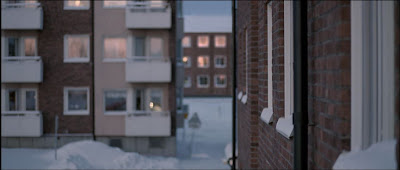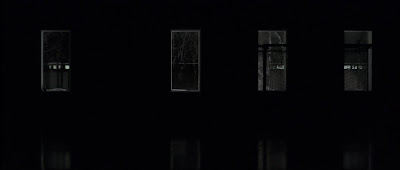This week's screen shots come from
Let the Right One In - one of the handful of outstanding vampire films in the 21st century (a decade of which has brought up more vampire films than you can shake a sharpened stake at.) It is a fine film, though one of it's unusual characteristics, among vampire books and films, is that the book is, in fact, even better than the movie. Stoker's
Dracula is top shelf, and there are so many derived films, that a good number of them don't measure up - but Nosferatu is better (that actually true for either Murnau's or Herzog's version) - with lesser vampire books (which are legion), this is almost universal. I mean - even the Twilight movie - the first one anyway, the only one I have had to watch (and read) - is almost a decent film, at least to a point.... This goes pretty far - last year, in the vampire class I mentioned a
couple times, the subject was broached from time to time - why (after
Dracula, and with a few exceptions here and there along the way), are these books so bad? why are there no (or very few) vampire books that are really good? Unspoken in this question, though it certain occurred to me, is the corollary - why are there so few serious and ambitious vampire books - and so many serious ambitious vampire films? Murnau, Dreyer, Herzog, Denis, Park, Maddin, etc.? And why are the schlocky vampire books so bad, and even run of the mill vampire films seem to have a spark? I don't know if I have an answer - except that vampires look so good on screen - or that vampires are, like films, shadows on the wall - or maybe that filmmakers have to create striking imagery to be frightening, and books - I don't know...
But that aside - this time, the book
Let the Right One In is better than the film - the book is simply outstanding. But the film is no slouch -handsome and understated, with a subtle touch for glorious horror imagery, tucking things into the backs and corners of the frame, like Eli climbing the wall in the back of this shot....

But one of it's best features is the use of spaces - the empty, stark, cold spaces of Blackeberg, a vision of Swedish hell, swallowing its inhabitants whole. The book (more than the movie, though some of this survives) seems to be explicitly about the return of a violent, pagan, past to the sterile, domesticated present - nature red in tooth and claw coming back to get its own. Though if Eli is a kind of hell visited on the modern world, the modern world is a kind of hell for her - and Tomas Alfredson shoots the suburb to make it look as horrifying as anything Eli might do.


















No comments:
Post a Comment